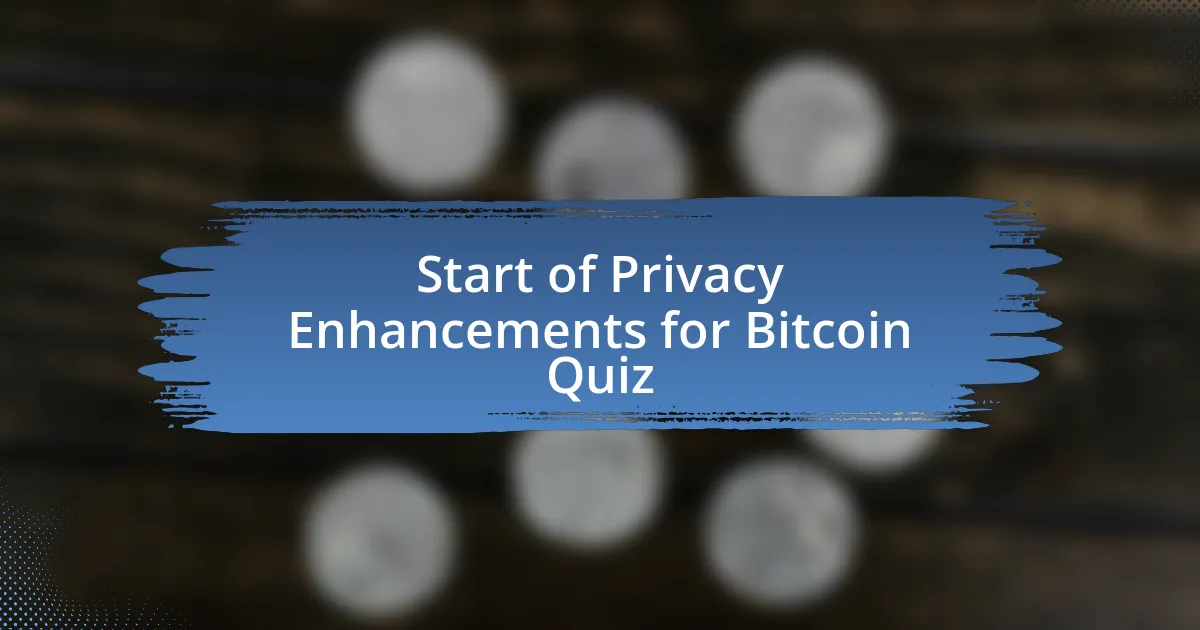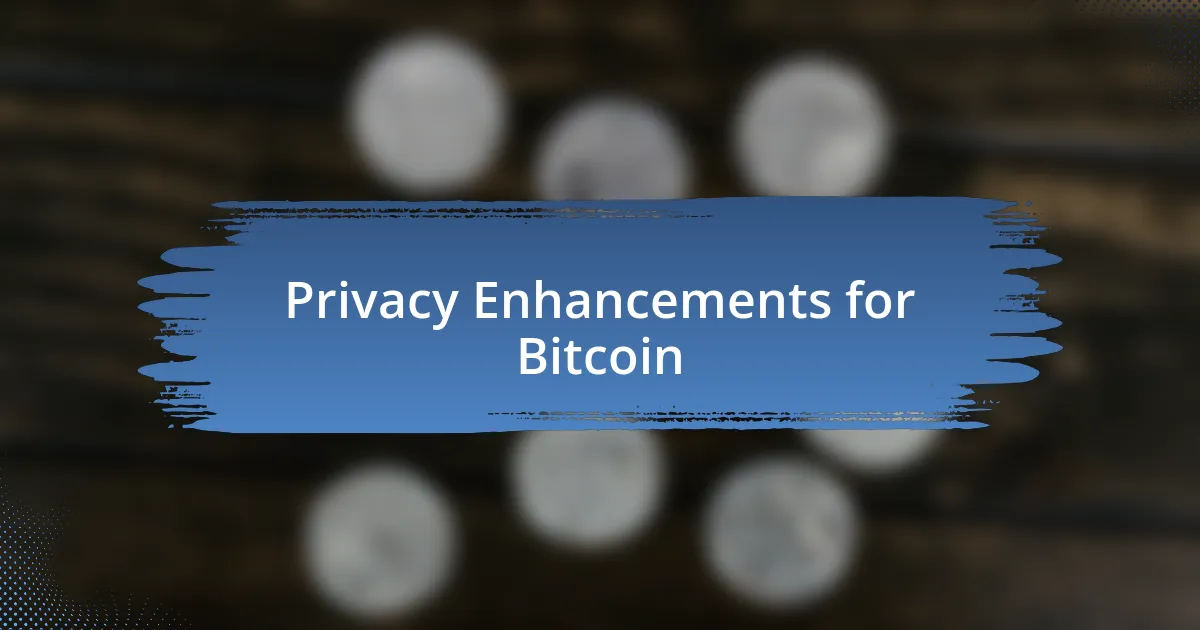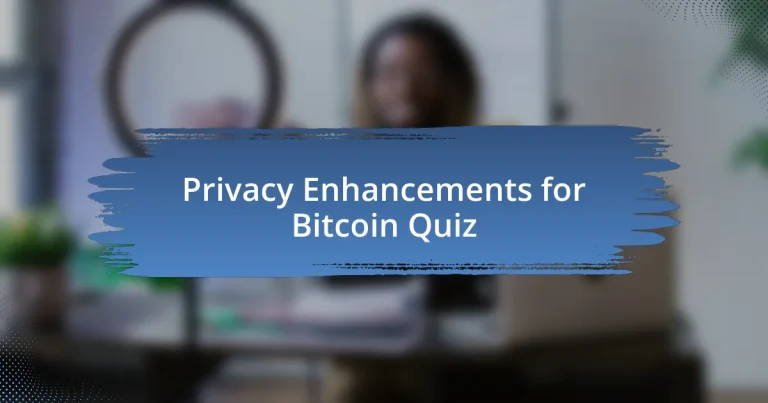
Start of Privacy Enhancements for Bitcoin Quiz
1. What are zero-knowledge proofs (ZKPs)?
- Zero-knowledge proofs are protocols that allow data sharing without any security checks.
- Zero-knowledge proofs are a method of encrypting messages to secure communications online.
- Zero-knowledge proofs are a way of proving a statement`s truth between two parties without revealing any information.
- Zero-knowledge proofs are algorithms that create random numbers for cryptographic use.
2. How do ZKPs enhance privacy in Bitcoin transactions?
- ZKPs make Bitcoin transactions completely anonymous without any disclosure.
- ZKPs can enhance privacy by allowing transaction validations without revealing all transaction information, as seen in `Shielded Transactions of Zcash.`
- ZKPs require all transaction information to be publicly disclosed for validation.
- ZKPs increase transaction speeds but do not affect privacy at all.
3. What is the primary function of zk-SNARKs in Zcash?
- zk-SNARKs verify the identity of the sender.
- zk-SNARKs increase transaction processing speed.
- zk-SNARKs allow for completely shielded transactions.
- zk-SNARKs reduce the transaction fee amounts.
4. How do zkLedger and zk-SNARKs ensure data integrity and confidentiality?
- zkLedger uses ZKPs to preserve transaction confidentiality while ensuring data integrity, and zk-SNARKs enable completely shielded transactions.
- zkLedger relies on traditional encryption methods while zk-SNARKs enhance speed without data integrity.
- zkLedger ensures data integrity by utilizing public ledgers, while zk-SNARKs only verify transaction amounts.
- zkLedger is solely focused on speeding up transactions, while zk-SNARKs ensure decentralized processing.
5. What is the purpose of Taproot in Bitcoin?
- Taproot enhances transaction privacy and reduces data required for sidechain transactions.
- Taproot is intended to make Bitcoin more centralized and easier to regulate.
- Taproot increases transaction size to improve security measures.
- Taproot allows for unlimited transactions in a single block.
6. What is the role of Schnorr signatures in Taproot?
- Schnorr signatures consolidate multiple signatures for enhanced transaction privacy.
- Schnorr signatures encrypt transaction details to prevent scrutiny.
- Schnorr signatures verify the authenticity of transactions using public keys.
- Schnorr signatures manage user identities in Bitcoin transactions.
7. How does the Lightning Network operate in relation to privacy?
- The Lightning Network aggregates off-chain transactions, and Taproot will encrypt these applications, enhancing privacy and scalability.
- The Lightning Network does not provide any privacy features, as all transactions are public.
- The Lightning Network only transmits on-chain transactions, which can be easily monitored.
- The Lightning Network relies solely on traditional encryption methods without any specific privacy enhancements.
8. What is the significance of Merkelized Abstract Syntax Trees (MAST) in Taproot?
- MAST in Taproot conceals smart contract unexecuted branches.
- MAST in Taproot eliminates the need for blockchain altogether.
- MAST in Taproot enhances transaction speed without privacy benefits.
- MAST in Taproot solely focuses on reducing transaction fees.
9. What is the purpose of using TOR hidden services with Bitcoin?
- TOR hidden services encrypt Bitcoin transactions to make them faster and more efficient.
- TOR hidden services allow users to obtain Bitcoin without any internet connection.
- TOR hidden services make Bitcoin transactions completely anonymous and untraceable.
- TOR hidden services conceal the source device and IP address when requesting or transmitting transaction information, enhancing privacy.
10. How does the use of encrypted digital signatures in Bitcoin maintain anonymity?
- Encrypted digital signatures in Bitcoin reveal the linked identities to all network users.
- Encrypted digital signatures in Bitcoin establish a connection between two parties while obscuring their identities.
- Encrypted digital signatures in Bitcoin make transactions visible but disguise transaction amounts.
- Encrypted digital signatures in Bitcoin only protect the transaction amounts but not the sender`s identity.
11. What is the impact of Segregated Witness (SegWit) on Bitcoin transaction privacy?
- SegWit improved Bitcoin users’ transaction privacy by enabling future updates like Schnorr Signatures and support for sidechains.
- SegWit decreased Bitcoin transaction privacy by removing several key encryption methods.
- SegWit had no effect on Bitcoin transaction privacy, as it only improved transaction speed.
- SegWit compromised Bitcoin transaction privacy by requiring more personal information for transactions.
12. What is the significance of Silent Payments protocol in enhancing Bitcoin privacy?
- Silent Payments protocol leverages mining rewards to enhance transaction security and decrease fees.
- Silent Payments protocol blends BTC transactions so they can’t be distinguished, using a unique one-time static address generated by the sender’s wallet.
- Silent Payments protocol increases the transaction speed by processing them off-chain.
- Silent Payments protocol relies on centralized servers for processing and verifying transactions.
13. How does the Silent Payments protocol prevent linking transactions to senders?
- The Silent Payments protocol generates a unique one-time static address for each transaction, making it impossible to link payments to the same sender.
- The Silent Payments protocol merges all transactions into a single address to simplify user experience and tracking.
- The Silent Payments protocol requires personal identification data from each sender to ensure security in transactions.
- The Silent Payments protocol tracks the transaction history of each sender to enhance clarity and transparency.
14. What is the difference between Silent Payments and PayNyms (BIP47)?
- Silent Payments does not broadcast linked wallets to payment codes, enhancing privacy.
- Silent Payments links transactions directly to the user`s wallet address.
- Silent Payments reveals all wallets linked to reusable payment codes.
- Silent Payments requires multiple transactions to obscure sender identity.
15. What is the primary goal of the Taproot upgrade in Bitcoin?
- The primary goal of Taproot is to improve transaction privacy while reducing the amount of data required for sidechain transactions.
- Taproot`s objective is to speed up the Bitcoin transaction confirmation times significantly.
- Taproot focuses on increasing the mining rewards for block validators.
- Taproot aims to eliminate all transaction fees within the Bitcoin network.
16. How does Taproot reduce transaction fees?
- Taproot increases transaction fees by adding more data to each transaction.
- Taproot eliminates transaction fees altogether for all Bitcoin transactions.
- Taproot reduces transaction fees by minimizing the data required for sidechain transactions.
- Taproot reduces transaction fees by speeding up the processing time of transactions.
17. What is the role of MAST in Taproot?
- MAST in Taproot is responsible for increasing Bitcoin`s mining rewards directly.
- MAST in Taproot ensures all transaction data is completely visible on the blockchain.
- MAST in Taproot conceals a smart contract’s unexecuted branches, enhancing privacy and scalability.
- MAST in Taproot allows for faster transaction confirmations by eliminating blocks.
18. How does Taproot enhance privacy for applications like CoinSwap?
- Taproot mandates the use of large transaction fees to maintain privacy in all applications.
- Taproot immediately reveals all transaction details, allowing for complete transparency at all times.
- Taproot limits transactions to a single direction, preventing any origin or destination disclosure.
- Taproot encrypts applications like CoinSwap, which combines Bitcoin transactions to obscure the origin and destination of the transaction.
19. What is the significance of using onion routing with the Lightning Network?
- Onion routing with the Lightning Network allows direct connections between users for faster transactions.
- Onion routing with the Lightning Network adds an extra layer of privacy by encrypting payment channels.
- Onion routing with the Lightning Network ensures complete transparency of payment channels.
- Onion routing with the Lightning Network speeds up transaction processing and reduces fees.
20. What is the main challenge in implementing onion routing with the Lightning Network?
- The limited number of nodes available.
- The high transaction fees associated with payments.
- The added complexity and network latency.
- The inability to use standard wallets for transactions.
21. What is the purpose of using a reusable payment code in Silent Payments?
- The reusable payment code in Silent Payments ensures that no payments are ever linked to the same sender, enhancing privacy.
- The reusable payment code allows for faster transaction speeds in Bitcoin payments.
- The reusable payment code is used to generate multiple wallets for a single user.
- The reusable payment code provides full transparency for all transactions made by a user.
22. How does the use of a unique one-time static address in Silent Payments enhance privacy?
- The unique one-time static address in Silent Payments links all transactions to a single user for transparency.
- The unique one-time static address in Silent Payments allows all transaction details to be publicly accessible.
- The unique one-time static address in Silent Payments prevents on-chain observers from identifying the owner of the address.
- The unique one-time static address in Silent Payments reveals the transaction history of the sender to observers.
23. What is the difference between BIP352 and BIP47 in terms of privacy?
- BIP352 reveals all transactions linked to a single payment address.
- BIP352 only enhances privacy through encryption methods, not address concealment.
- BIP352 does not broadcast which wallets are linked to a reusable payment code, unlike BIP47 which only obscures it.
- BIP352 requires multiple transactions to secure user identity.
24. What is the main advantage of using BIP352 over BIP47?
- BIP352 causes longer transaction times due to extra security checks.
- The main advantage of BIP352 is that it does not require users to send fee-burdened two transactions for a single payment.
- BIP352 requires multiple confirmations for each transaction to maintain security.
- BIP352 increases the transaction fees to enhance network security.
25. How does the use of new addresses to receive payments enhance privacy in Bitcoin?
- Using a single address for all transactions increases visibility and traceability.
- Using public keys improves transaction speeds but does not enhance privacy.
- Using old addresses for new transactions maintains transaction history visibility.
- Using new addresses prevents linking multiple transactions to the same address, enhancing anonymity.
26. What is the significance of being careful with public spaces when using Bitcoin?
- Being careful with public spaces prevents others from accessing your device and potentially compromising your transaction information.
- Being careful with public spaces eliminates transaction fees entirely.
- Being careful with public spaces enables free Bitcoin withdrawals.
- Being careful with public spaces increases the speed of Bitcoin transactions.
27. How can an individual protect their IP address when using Bitcoin?
- An individual can protect their IP address by sharing it with trusted friends, which keeps it safe from others.
- An individual can protect their IP address by using public Wi-Fi, which obscures their location.
- An individual can protect their IP address by using a standard browser, which hides their online activity.
- An individual can protect their IP address by using TOR hidden services, which conceal the source device and IP address.
28. What is the role of graphical user interfaces in enhancing Bitcoin privacy?
- Graphical user interfaces rely on public key infrastructure, which compromises Bitcoin privacy significantly.
- Graphical user interfaces can provide user-friendly payment request features and discourage address reuse, enhancing privacy.
- Graphical user interfaces expose all transaction details, making it easier to track users and decreasing privacy.
- Graphical user interfaces increase transaction fees and slow down processing times, reducing privacy.
29. What are some ongoing efforts to improve Bitcoin privacy?
- Ongoing efforts include implementing faster transaction speeds to reduce the confirmation time for all users.
- Ongoing efforts include developing extended privacy features like joining random users’ transactions together and improving payment messages API to avoid tainting multiple addresses.
- Ongoing efforts involve creating more public address formats to enhance visibility during transactions.
- Ongoing efforts focus on expanding transaction fees to limit the number of users involved in Bitcoin transactions.
30. How does the use of change addresses in Bitcoin wallets enhance privacy?
- Change addresses store transaction history for easy tracking.
- Change addresses allow multiple transactions to be combined into one.
- Change addresses make transactions faster by reducing confirmation time.
- Using new addresses for each transaction prevents linking transactions.

Quiz Completed Successfully!
Congratulations on completing the quiz on ‘Privacy Enhancements for Bitcoin’! We hope you found the questions engaging and informative. Understanding privacy in the Bitcoin ecosystem is crucial in today’s digital age. You’ve gained insights into various privacy techniques and technologies that can help secure your transactions and identity.
Throughout the quiz, you learned how privacy tools like CoinJoin and confidential transactions can enhance your Bitcoin experience. You may now appreciate the importance of maintaining anonymity while using cryptocurrencies. This knowledge empowers you to make informed decisions that protect your financial information.
To delve deeper into this fascinating subject, we invite you to explore the next section on this page. Here, you’ll find comprehensive information on ‘Privacy Enhancements for Bitcoin.’ This resource will further expand your understanding and keep you updated on the latest developments in cryptocurrency privacy. Happy learning!

Privacy Enhancements for Bitcoin
Understanding Privacy in Bitcoin Transactions
Privacy in Bitcoin transactions refers to the concept of keeping user identities and transaction details confidential. Bitcoin operates on a public ledger called the blockchain, where all transactions are visible. Despite this openness, various methods exist to enhance user privacy. These methods aim to obscure the source and destination of Bitcoin, making it challenging for outside observers to trace transaction history. Enhancing privacy can prevent potential misuse of transaction information and protect user identities from unwanted scrutiny.
Common Privacy Enhancements for Bitcoin
Common privacy enhancements for Bitcoin include techniques like CoinJoin, stealth addresses, and mixing services. CoinJoin combines multiple users’ transactions into a single transaction, complicating the tracing process. Stealth addresses generate a unique address for each transaction, preventing linkability to a user’s wallet. Mixing services shuffle coins among multiple users to break the on-chain link between sender and receiver, obfuscating transaction trails. These methods collectively improve transaction privacy on the Bitcoin network.
CoinJoin: A Method for Enhanced Privacy
CoinJoin is a collaborative transaction method designed to increase privacy by merging several users’ funds into one transaction. By doing so, it makes it challenging to identify the source and destination addresses of the individual transactions. This method leverages the fundamental Bitcoin protocol, allowing participants to maintain control over their funds. Various implementations of CoinJoin, such as Wasabi Wallet and Samurai Wallet, have emerged, each contributing to improved user anonymity in Bitcoin transactions.
Stealth Addresses and Their Role in Privacy
Stealth addresses enhance privacy by creating a unique address for each transaction, which is not publicly linked to the user’s wallet address. When a Bitcoin user receives funds, a temporary address is generated, ensuring that only the sender and recipient can trace the transaction. This method protects user identity by making it difficult for external observers to correlate multiple transactions to a single user. Stealth addresses are particularly helpful in protecting users from unwanted tracking and profiling by third parties.
The Impact of Privacy Coins on Bitcoin’s Privacy Enhancements
Privacy coins like Monero and Zcash have influenced privacy enhancements within Bitcoin. These coins offer advanced privacy features, such as stealth addresses and ring signatures, which provide additional layers of anonymity. The techniques developed in privacy coins have prompted Bitcoin developers to explore integrating similar features. While Bitcoin remains a transparent network, the growing awareness and demand for privacy trigger ongoing discussions about improving its privacy capabilities through potential updates and enhancements.
What are privacy enhancements for Bitcoin?
Privacy enhancements for Bitcoin refer to various methods and technologies designed to increase the anonymity of Bitcoin transactions. These include coin mixing services, which obscure the origin of coins by blending them with others, and technologies like Confidential Transactions, which hide transaction amounts. The implementation of these enhancements aims to prevent analysis of blockchain data, thus protecting user identities and transaction details.
How do privacy enhancements work?
Privacy enhancements work by obfuscating transaction information on the Bitcoin blockchain. For example, coin mixers take multiple users’ coins and combine them, making it difficult to trace their original sources. Technologies like Zero-Knowledge Proofs allow transaction validation without revealing any information about the sender, receiver, or the amount involved, ensuring confidentiality while maintaining network integrity.
Where can users access privacy enhancements for Bitcoin?
Users can access privacy enhancements for Bitcoin through various wallets that offer built-in features for increased anonymity, such as Wasabi Wallet and Samourai Wallet. Additionally, online services like JoinMarket and CoinJoins facilitate coin mixing. Some exchanges also provide privacy-focused features, although these are less common due to regulatory concerns.
When should users implement privacy enhancements for Bitcoin?
Users should implement privacy enhancements for Bitcoin whenever they make transactions that could expose their financial activity or identities. This is especially important when users intend to hold large amounts of Bitcoin, conduct multiple transactions, or interact with high-profile entities. Implementing these enhancements prior to any significant transactions reduces the risk of unwanted surveillance or data linking.
Who benefits from privacy enhancements for Bitcoin?
Individuals concerned about financial privacy and security benefit from privacy enhancements for Bitcoin. This includes activists, journalists, and users living under restrictive regimes where financial privacy is crucial. Additionally, anyone wanting to shield their financial habits from potential hackers or data analysts can gain significant advantages from these enhancements, as they protect personal and financial information.


